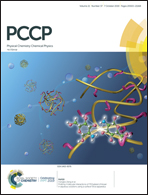The use of ion-selective membranes to study cation transport in hybrid organic–inorganic perovskites†
Abstract
Using a methylammonium selective membrane in conjunction with electrochemical impedance spectroscopy, we measured ion migration in methylammonium lead triiodide (MAPbI3) with a millisecond (ms) time constant under illumination. These values were consistent with the reported values of ionic conduction in thin-film perovskite solar cells. We monitored an electrochemical impedance response arising from ionic conductivity through MAPbI3 and a methylammonium selective layer. We could fit this complex impedance response to an intuitive circuit model, which revealed an ionic species moving on a ms time scale. Electrospray ionization mass spectrometry (ESI-MS) revealed direct chemical evidence of methylammonium diffusion into the ion-selective layer. We found no experimental evidence indicating the mobility of lead ions or protons, suggesting that the mobile species observed under illumination is likely methylammonium.



 Please wait while we load your content...
Please wait while we load your content...
